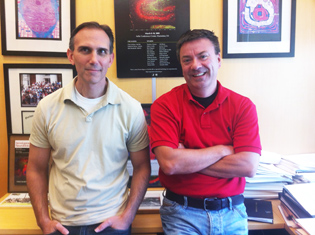Something Old, Something New
NICHD Neuroscientists Link Neuron Age to Memory Formation

MEGAN WYETH, NICHD
NICHD neuroscientists Kenneth Pelkey (left) and Christopher McBain were collaborators on a recent Cell study that links neuron age to the formation of memories.
Episodic memory requires both pattern separation and pattern completion. In forming distinct memories of similar events, pattern separation allows one to distinguish between similar-but-different cues, such as your father’s face and his brother’s face. Pattern completion involves recalling more complete memories based on partial cues: For example, seeing your father’s face triggers your recall of where you last saw him. Scientists have long thought that the granule cells (GCs) in the hippocampus’s dentate gyrus (DG)—one of only two brain areas in which neurogenesis occurs during adulthood—was responsible for pattern separation and were another hippocampal region, area 3 of the cornu ammonis (CA3), supported pattern completion.Deep in the center of the brain is the cashew-size hippocampus, an organ essential to the formation of new memories. Without it we’d only remember the old ones. Scientists thought they understood how certain cells within the hippocampus played a crucial role in episodic memory. But recently, two NICHD neuroscientists—Christopher McBain and Kenneth Pelkey—contributed to a discovery that has turned that thinking on its head. (Cell 149:188–201, 2012)
Susumu Tonegawa at the Massachusetts Institute of Technology (MIT; Cambridge, Mass.) led a group of researchers seeking to determine the relative contributions of young and old adult-born GCs in mice. GCs that are less than four weeks old are considered young. The researchers were able to halt the formation of new GCs with X-ray irradiation. But Tonegawa knew that blocking the function of the older cells, while leaving the younger ones intact, would be tricky. He created a transgenic mouse in which he blocked the output of the hippocampus’s mossy-fiber pathway, so named for the GCs’ mossy-looking axons. But how would he know whether he had successfully silenced the older GCs?
That’s where the NICHD researchers came in. McBain was an expert in the hippocampal mossy-fiber pathway and was among the first to look at novel mechanisms of synaptic plasticity within it. Pelkey had played an integral part in the lab’s discovery of a receptor that when activated weakens signaling between the dentate gyrus and inhibitory interneurons of the CA3 region; in its absence, signaling is strengthened. (Neuron 46:89-102, 2005)
Tonegawa’s group needed to “prove that the beast they made was in fact what they thought they [had] made,” said Pelkey.
To test whether the mossy-fiber pathway had been silenced, Pelkey made electrophysiological recordings on neural tissue from Tonegawa’s mice—some of which were genetically engineered and some not. McBain and Pelkey were blind to which mice were which. The results confirmed that the mossy-fiber pathway was indeed inhibited in the transgenic mice.
Meanwhile, the researchers at MIT and others at the University of California, Los Angeles, were “off doing their part of the puzzle, blind to what everyone else was up to,” said McBain. Behavioral tests were conducted to assess pattern-separation and pattern-completion abilities in the experimental and control mice. To measure pattern separation, the researchers used fear-conditioning tests to see how well the mice distinguished between fear-inducing and safe situations. To evaluate pattern completion, the researchers used a standard reference-memory version of the water-maze task, in which the mice were trained to recognize full and partial cues to help them navigate to an underwater platform in opaque water.
Surprisingly, the DG, which had previously been associated only with pattern separation, was found to be responsible for both pattern separation and pattern completion. The adult-born dentate granule cells (a layer of tightly packed granule cells within the DG that produce mossy fibers) switch functions as they age: for the first four weeks they support pattern separation; then as they mature they facilitate pattern completion.
The discovery has implications not only for understanding how the brain stores new memories without forgetting the old, but also for treating mental-health disorders such as “epilepsies and stroke and stress and percussive head trauma,” which, said McBain, “tend to have their impact largely inside the temporal lobe where the hippocampus resides.”
This page was last updated on Friday, April 29, 2022
